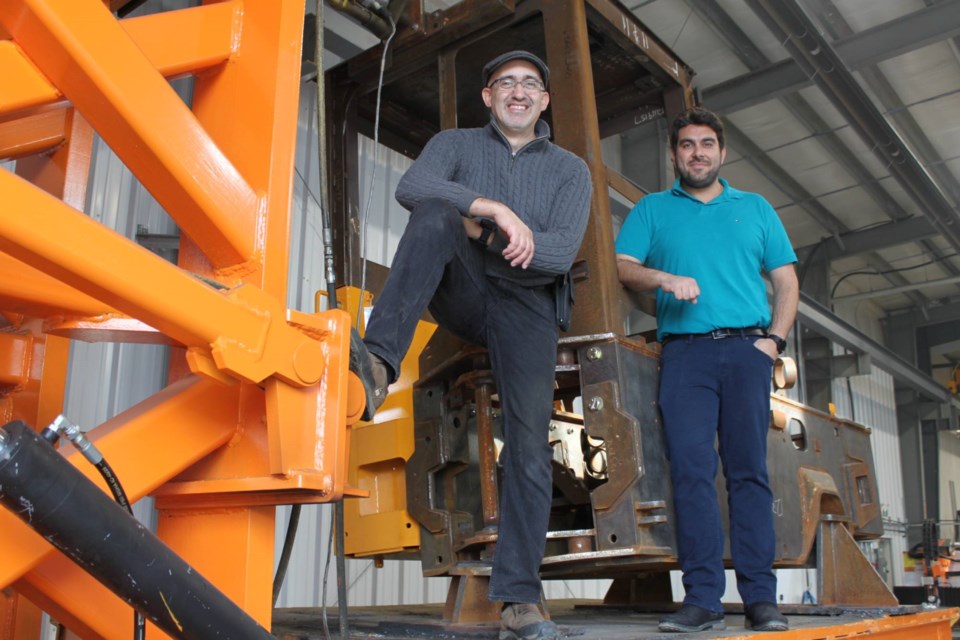No engineer likes to hear that their design has failed.
But when it comes to protecting workers from vehicle rollovers and falling objects — when the result could make the difference in ensuring a worker goes home safely — it’s better to know before a vehicle goes into service than to find out after tragedy has already struck.
That’s been the driving ideology at TopROPS since Savy Bhardwaj launched the company in 2013.
His Sudbury-area business, and its sister company TopSTEEL, manufacture and certify rollover protective structures (ROPS) and falling object protective structures (FOPS) for heavy-duty industrial and commercial equipment and machinery, specializing in the mining industry.
ROPS and FOPS are the steel, cage-like frames on a vehicle’s cab that protect the driver in the case of a rollover or a falling heavy object, such as loose rock.
It’s a niche service that very few shops in Canada or the U.S. provide, Bhardwaj said.
“Anything that sits on an operator, we engineer it,” said Bhardwaj, a certified and licensed engineering technologist, and president at the company.
“We do computer simulations, we do fabrication, we do physical testing, and we upfit. We do it all, from A to Z.”
The key element that differentiates TopROPS is the physical testing.
In the past, engineers designed a structure, ran it through a simulator and, after it passed, gave the design their seal of approval.
But in a simulation, the computer tests ROPS against a perfect scenario, Bhardwaj said, yet there can be a 20 to 40 per cent difference in performance between the simulation and a physical test.
Industry has recognized this, and now physical testing is mandatory.
In a physical test, a rollover protective structure is put on a large steel device called a jig that slowly applies pressure amounting to twice the overall weight of the vehicle it’s being used for. The ROPS is rotated and tested on all four sides, and if it meets industry specifications, it’s given a passing grade.
There’s a “very fine line” of what is considered safe, Bhardwaj said, and testing helps ensure the product meets that exacting standard.
“The energy gets absorbed by the machine, goes through the tires, and out into the ground,” he explained. “If you make (the ROPS) too strong, the operator will go. If you make it too weak, the operator will go, too. There has to be a balancing point. That’s how these things are designed.”
In the early days of his career, Bhardwaj worked with TopROPS' predecessor, whose jig could test for up to 50,000 pounds of weight.
As underground mining machines got bigger — and heavier — TopROPS evolved, too, and about seven years ago, the company built a 200,000-pound jig.
But today’s modernized machines, many of which are made heavier by battery electric technology, dwarf those of even a few years ago, and now that second jig is outdated, too.
“Machines are getting bigger and bigger. How are you going to test it? How are you going to put it on the jig?” Bhardwaj said. “You can’t do it. There’s nothing out there.”
Until now.
This fall, TopROPS unveiled its newest iteration: a one-million-pound jig.
In the works for two years, the hefty steel structure was designed and constructed on site, in a purpose-built facility that enables the company to test ROPS inside year-round.
It can accommodate machines weighing up to one million pounds, which Bhardwaj estimates should meet industry need for at least the next five years.
Building it was a gamble, especially when the price of steel skyrocketed through the pandemic, but Bhardwaj believes there is a need, especially among smaller, low-volume equipment manufacturers, for this service.
“We just went all in: just make a million-pound rig, just put it up there,” he said. “Let’s see what happens.”
The multi-million-dollar endeavour was made a little easier with help from the Northern Ontario Heritage Fund, said Bhardwaj, who also outfitted the facility with new fabrication equipment in anticipation of added business.
And his venture is starting to pay off: he’s already quoted at least one company on work that he had to refuse three years ago because he didn’t have the capacity for testing.
Next up is the launch of a new division: TopCABS.
Starting in early 2023, Bhardwaj and his staff will take orders for full cabs for vehicles. That includes designing, building and testing the cabs, along with the installation of wiring, insulation, cushions, seats, glass, controls, and any other needed parts. Once complete, the cabs just have to be bolted to a vehicle and they’ll be ready for use.
Bhardwaj said he’d been approached for years about offering this type of solution by companies who were tired of spending the time and effort sourcing all their own components.
Now, companies can give him the order and his shop will do everything from start to finish.
“We are giving customers a complete solution,” he said.
The company has brought on two full-time sales reps to market its services, and TopROPS is currently negotiating to expand its U.S. dealer network to gain exposure there. If business takes off, Bhardwaj said he expects to need more hires to add to his current complement of 20.




